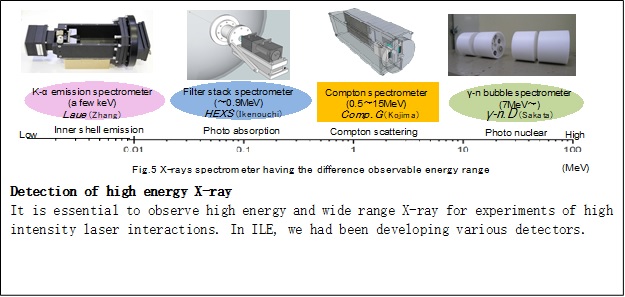Exploration of New Quantum Field Science(ENEQs)
Summary
Our group aims to develop a new research field of quantum mechanics in strong electromagnetic fields produced by high-intensity laser.
Owing to the discovery of chirped pulse amplification, the irradiation intensity of laser light has been dramatically enhanced to 3 or 4 orders of magnitude, and has since sparked novel applications of such high intensity laser in various fields. New experimental studies of nonlinear electromagnetism and quantum chromodynamics are expected to be developed in the future, such as the interaction between the high-intensity laser and vacuum (e.g., vacuum polarization and Unruh radiation), verification of axion-like particles, and generation of a Quark-Gluon Plasma via the collision of heavy particles directly accelerated by the laser. Through experimental proposals that will be feasible in future devices, our group will take the lead in the development of laser systems that can bring forth realistic experimental parameters for these experiments.
In addition to the strong electromagnetic fields, various challenges could arise from the extreme conditions generated by the high intensity laser. For example, solid state physics in ultra-high pressure or density and quantum phenomena in extremely strong electromagnetic fields are open problems. ILE has been striving to shed light on these problems, and therefore, we shall also open up research channels to explore these problems through joint collaborations.
Research topics
Pair creation of electron and positron by high intensity laser
A high intensity laser is expected to generate unprecedented high dense pairs of electron and positron. The generation process is called the Bethe-Heitler process, which is well known in quantum electrodynamics. Such a high dense state is regarded as a high-density and high-energy (about MeV) relativistic plasma, and it is expected to be a novel experimental platform for laser astrophysics. This study is also an important step for experiments of vacuum collapse and collision of electron and positron.
Moreover, the generation of a high-density positron beam is expected to be utilized in both fundamental physics and applications. For fundamental studies, it is important to compose anti-hydrogen atom and study electron-positron plasma. For applications, the pair creation will be instrumental to the scattering of atoms and molecules, can facilitate the search for electron state and lattice defects of solid surfaces, interfaces, and bulks, and can be used as a probe beam in material science.
Development of polarized fuel for nuclear fusion
The main nuclear reactions in thermal nuclear fusion are D + T→ 4He + n and D + 3He→ 4He + p. These reactions proceed via resonant states, in which the nuclear spin becomes 3/2, given by adding 1+1/2. Therefore, considering the statistical weight, only 2/3 of isotropic collisions can contribute to the reactions. Conversely, if we can straighten the nuclear spin, the reaction cross section can be enhanced by 50%. If a polarized fuel is supplied, it will be a welcome development for studies of thermal nuclear fusion such as the International Thermonuclear Experimental Reactor (ITER) and National Ignition Facility (NIF, USA). We are developing a method to generate and sustain the polarized state, for example, by laser-induced polarization and keeping in the ferromagnetic complex.
Analysis of theoretical framework of nonlinear electromagnetism and realistic proposals for experimental detection
Classical electromagnetism is considered to be modified by quantum electrodynamics or by interaction with unknown particles. In this viewpoint, the vacuum is not a transparent medium where light can pass through unhindered. Instead, it acts as a nonlinear medium that changes the color or direction of an incoming light. Although both theoretical and experimental researches have been done, nonlinear electromagnetism is not yet established, especially its experimental proof.
Our group’s theoretical approach to nonlinear electromagnetism uses the Lagrangian formalism. There are two main objectives for our work. One is to search for a framework that can address problems in the theory from a mathematical standpoint. Fundamental problems such as the uniqueness of solution is an example that we are working on. Another key objective for our group is to design a realistic experimental setup using an existing device, and not only those that will be available in the far-future, to show proof of nonlinear electromagnetism.
Members
| NAKAI Mitsuo | Professor |
| SHIBATA Kazunori | Assistant Professor |

